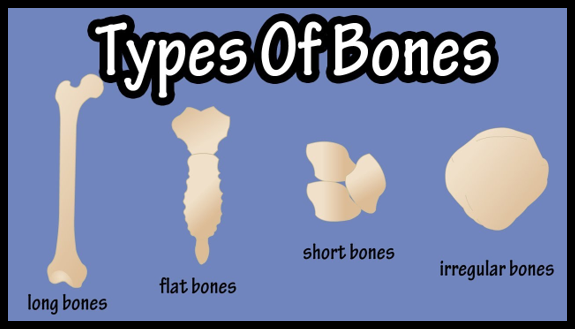
SKELETAL SYSTEM
Objectives:
Watch this video as an introduction to the skeletal system.
Functions of the Skeletal System
The skeletal system consists of 206 bones and all of the joints in the body. These bones and joints make up the internal framework of the body called the skeleton. The skeleton supports the body, protects the internal organs, serves as a point of attachment of the skeletal muscles for body movements, and produces blood cells that store minerals in the body. The term skeleton was originally used in reference to a dried-up mummified body, but over time came to be used for bones.
Bones
Bones are one of the hardest materials in the human body. The strength of bones are dependent on calcium and phosphorus. Bones are also referred to as osseous tissue. The bones in the body are formed before birth and made of cartilage. This happens through a process called ossification. Osteoblasts replace this cartilage with bone during development. Once adulthood is reached, the osteoblasts have matured into osteocytes.
Here are four categories of bones in the human body. The first category is classified as a long bone. Long bones are longer than they are wide. An example of a long bone is the femur. The second category is classified as a short bone. Short bones are roughly as long as they are wide. An example of a short bone in the body are the carpals. The third category is classified as a flat bone. Flat bones are plate like shaped. The sternum is an example of a flat bone. The last classification of bones in the body are irregular bones. These types of bones have irregular or odd shapes. The vertebrae is an example of an irregular bone in the body.
Figure 1: Types of Bones |
 |
Most of the bones in the human body are long bones. All of the long bones have similar structures with a central shaft called a diaphysis. The diaphysis widens at each end of the bone. The ends of the bone are called epiphysis. The epiphysis is covered by a layer of artificial cartilage. This cartilage acts like a cushion and prevents the bones and joints from rubbing directly on one another. The rest of the bone surface is covered with a thin connective tissue membrane called the periosteum. The exterior surface of a bone is dense and hard. It is called cortical or compact bone. The inside of the bone is called cancellous or spongy bone. As the name indicates, the spongy bone has space in it. This space contains red bone marrow which manufactures most of the blood cells found in the bone. As a person ages, the red bone marrow converts to yellow bone marrow. The yellow bone marrow consists mainly of fat cells and is located in the medullary cavity of the bone. Study the diagram of a long bone below.
Figure 2: Long Bone |
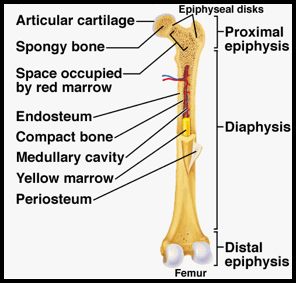 |
Bone Projections and Depressions
Bones have many projections and depressions. Projections form where tendons and ligaments attach. The term depression is used to describe movement of a joint. Some projections and depressions are rounded while others are smooth. Round and smooth articulate with another bone in a joint. Some projections and depressions are rough and provide muscles with attachment points. The general term for any bony projection is called a process. The elbow, commonly called the funny bone, is actually a projection of the ulna called the olecranon process. The following terms are used in physicians’ records for clear identifications of areas on the individual bones.
Click here to view Table 1 - Bony Processes in the Body.
Figure 3: Bony Processes |
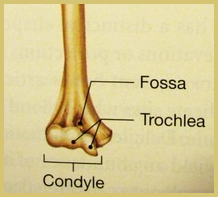 |
Skeleton
The human skeleton has two divisions: the axial skeleton and the appendicular skeleton. Below is a picture of both divisions.
Figure 4: Axial and Appendicular Skeleton |
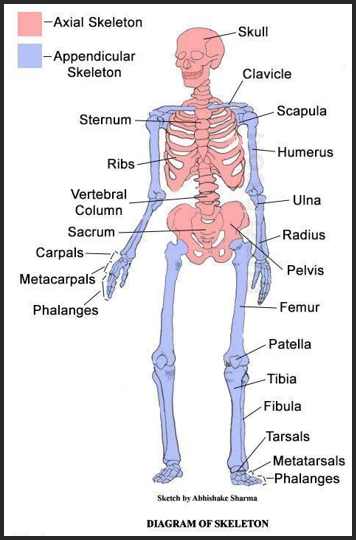 |
The Axial Skeleton
The axial skeleton includes the bones of the head, neck, spine, chest, and trunk of the body. These bones form the central axis for the whole body. It protects many of the internal organs such as the brain, eyes, ears, nasal cavity, and oral cavity.
The head or skull is divided into two parts consisting of the cranium and facial bones. These bones surround and protect the brain, eyes, ears, nasal cavity, and oral cavity from injury. The muscles for chewing and the muscles for moving the head attach to the cranial bones. The cranial and facial bones are labeled below.
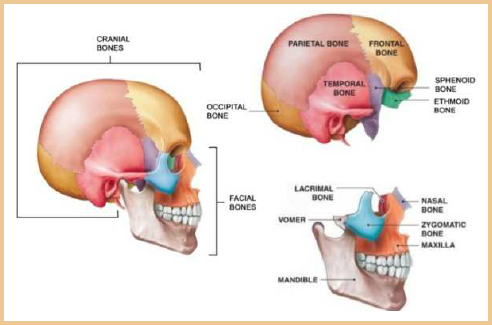 |
Click here to view Table 2 - Bones of the Skull. Quizlet
Figure 5 - Vertebral Column |
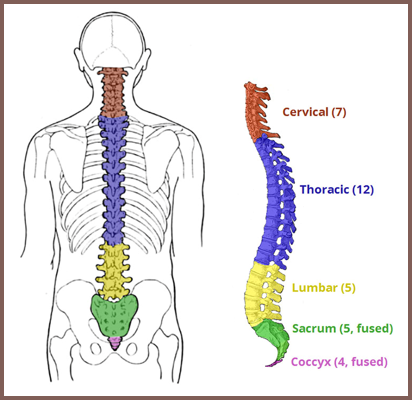 |
Figure 6 - Structure of the Rib Cage |
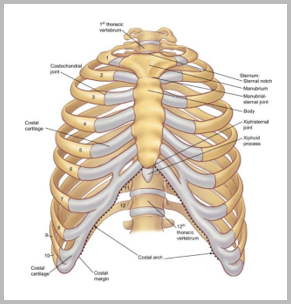 |
The Appendicular Skeleton
The appendicular skeleton consists of the pectoral girdle, upper extremities, pelvic girdle, and the lower extremities. These bones are responsible for body movement. The figures below show the four sections of the appendicular skeleton.
Figure 7 - Pectoral Girdle |
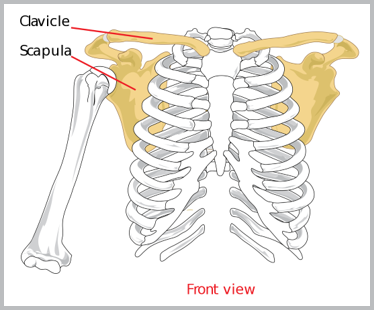 |
Figure 8 - Upper Extremities |
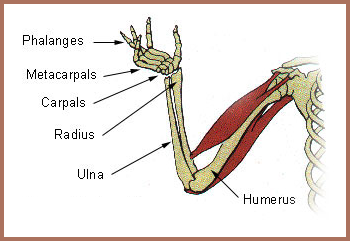 |
Figure 9 - lower Extremities |
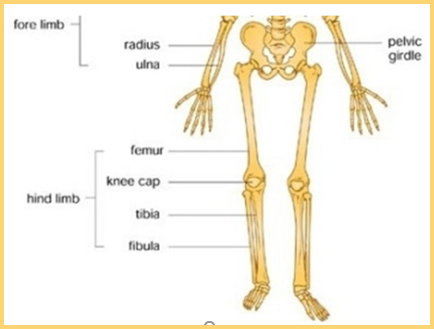 |
Figure 10 - Pelvic Girdle |
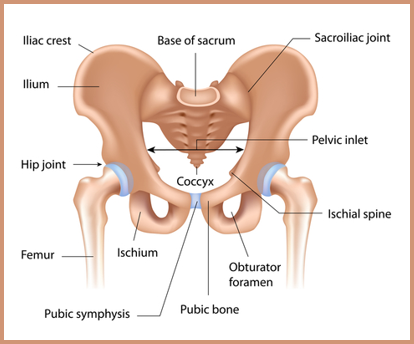 |
Figure 11 - Joints in the Body |
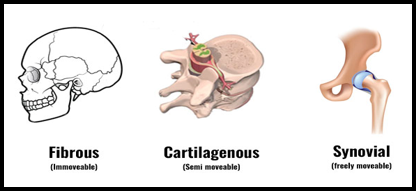 |
![]() Click on the check mark to evalutate your work!
Click on the check mark to evalutate your work!
Terminology of the Skeletal System
The following lists contain the combining forms, suffixes, and prefixes used to build terms in the remaining sections of this unit.
Click here to view Table 6 - Combining Forms of the Skeletal System. Quizlet
Click here to view Table 7 - Suffixes of the Skeletal System. Quizlet
Click here to view Table 8 - Prefixes of the Skeletal System. Quizlet
Click here to view Table 9 - Adjective Forms of Anatomical Terms of the Skeletal System. Quizlet
**Complete Exercise 2 - Click here for the printable reading.
![]() Click on the check mark to evalutate your work!
Click on the check mark to evalutate your work!
Click here to view 10 - Pathology of the Skeletal System. Quizlet
**Complete Exercise 3 - Click here for the printable reading.
![]() Click on the check mark to evalutate your work!
Click on the check mark to evalutate your work!
Click here to view Table 11 - Diagnostic Procedures of the Skeletal System. Quizlet
Click here to view Table 12 - Therapeutic Procedures of the Skeletal System. Quizlet
Click here to view Table 13 - Pharmacology of the Skeletal System. Quizlet
Click here to view Table 14 - Abbreviations of the Skeletal System. Quizlet
**Complete Exercise 4 - Click here for the printable reading.
![]() Click on the check mark to evalutate your work!
Click on the check mark to evalutate your work!